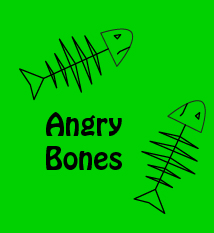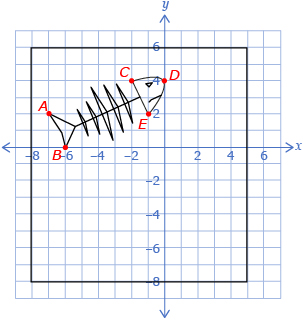Lesson 5
1. Lesson 5
1.1. Discover
Module 5: Geometry
Discover
In the previous lesson, you explored four different types of transformations: translations, reflections, rotations, and dilations. In the next activity, you will explore how multiple transformations can be used.
Try This 1

Chad has drawn an emblem for his band “Angry Bones.”
- What transformation or combination of transformations could Chad have used to place the bottom fish skeleton once he drew the top one?
- Print or sketch the Angry Bones Template. Cut out the two fish templates on the right side.
Describe how you can use the template to test your prediction from part a. - Test your prediction using the template. How accurate is your test?
Suppose Chad told you he chose some important points on the illustration, reflected them over the x-axis, and then rotated the diagram 90° counterclockwise about the origin to determine the new positions.

- Check to see if Chad’s instructions are correct. Start by completing the following table.

Original Point
Original Point Reflected Across the x-axis
Reflected Point Rotated 90° Counterclockwise
A(−7, 2)
A′(−7, 2)
A″(−7, 2)
B(−6, 0)
C(−2, 4)
D(0, 4)
E(−1, 2)
- Plot the points that have been reflected and rotated to decide if Chad’s instructions are correct. If you printed the template, use it to plot your points.
- Predict whether the instructions “rotate the illustration 90° counterclockwise about the origin and then reflect the points vertically” gives the same picture as the instructions Chad gave.
- Complete a table like the one shown.
Original Point
Original Point Rotated 90° Counterclockwise
Rotated Point Reflected Across the x-axis
A(−7, 2)
B(−6, 0)
C(−2, 4)
D(0, 4)
E(−1, 2)
- Plot the rotated and reflected points to decide if the two sets of instructions are equivalent. If you printed the template previously, use it to plot your points.

- What can you conclude about the order of transformations applied to a figure?
![]() Save your responses in your course folder.
Save your responses in your course folder.